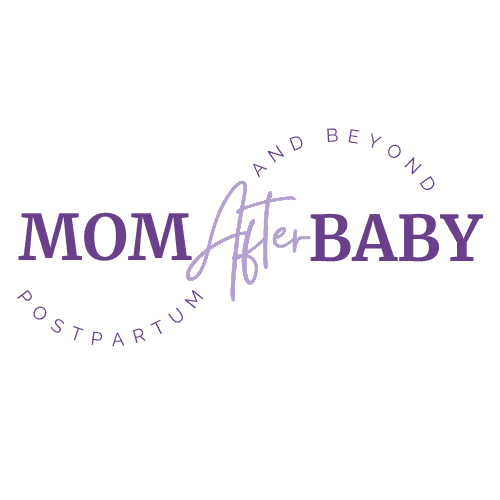How to Clear a Clogged Milk Duct FAST & from Home
This post may contain affiliate links that I may receive a commission from if you click & buy. In addition, the information on this site is NOT intended to be medical advice. See my full policy for more information.
Breastfeeding is a hard enough task as is. Yet, you’re reading this article because you probably have a plugged duct that you need to relieve fast. Fortunately, you can often dislodge a blocked duct at home. Keep reading to learn the best ways on how to clear a clogged milk duct.
I struggled with clogged milk ducts and breast engorgement after my 2nd child was born. I remember being up super late in the middle of the night looking up the best tips to unclog a milk duct. Let’s put it this way, it’s no fun.
We all know breastfeeding is full of challenges such as sore nipples, managing milk production, trying to perfect your baby’s latch, learning the best positions, and so much more. Struggling to relieve backed-up milk stuck in your breast is not something any mom wants to be dealing with. So, let me walk you through some of my favorite ways to bust those stubborn clogs.
Get your warm packs & Haakaas ready because we’re about to relieve some clogged ducts!
**As of 2022, the ABM (Academy of Breastfeeding Medicine) announced an updated protocol that does NOT recommend saline soaks or castor oil for mastitis. Contrary to many women having anecdotal evidence in support of saline soaks, it’s important to be aware of this protocol so that you can make the most educated decision for yourself as a breastfeeding mother.**
How to Clear a Clogged Milk Duct At Home
Please remember that these tips don’t intend to take the place of medical advice. I’m a mom sharing the many ways that helped me when I was on my breastfeeding journey.
Many of these tips I got from my own International Board Certified Lactation Consultant. However, if you ever have concerns that warrant medical attention, please contact your healthcare provider right away.
Try a Castor Oil Compress For Clogged Ducts
According to Healthline, castor oil use on the skin helps to “fight inflammation, reduce bacteria and soothe irritated skin”.
This is why it’s no surprise this method works wonders (as suggested by my lactation consultant) to help bust out a clogged milk duct!
Plus, applying this compress is easy! All you need is a small washcloth and some castor oil.
- Take your washcloth and run it underwater so it’s nice and damp.
- Then, fold it into a small square (about the size of your hand) and gently pour the castor oil onto ONE side. Don’t drench it, just lightly cover one side with oil.
- Stick the cloth into the microwave for about 10-15 seconds so it is warm to the touch (SHOULD NOT BE HOT).
- Apply the cloth to the affected part of your breast (wherever the clog is) & leave it on for 20 minutes.
- After you’re finished, make sure you thoroughly clean your breast as you do not want the oil to be ingested by your baby. Castor oil is known for causing some serious GI Upset so we want to avoid ingestion by the baby.
A few things to keep in mind is that castor oil can stain easily, so one tip is to use some saran wrap between the compress and your clothing. Some suggest going completely bare to avoid any staining of clothing at all.
Remember, you may need to try a few compresses throughout the day to ensure the entire clog is broken up and eventually dispels.
Use Heat (Warm Compresses) & Massages
Using a warm compress is a very effective way to open up those milk ducts allowing a better flow of milk to run through them. You can use warm packs or even a nice warm shower! I personally use these warm packs as I find them to be much easier & you can take them anywhere!
Pair that with some gentle massaging of the breast to stimulate the clog to break down and pass through the nipple can be an effective way to bust that clog.
In fact, in order to prevent clogs, I would use this method on the area of the breast that use to get clogged when I was breastfeeding. It didn’t always work, but it did help minimize the number of times I ended up with a clogged duct.
Here’s the exact routine I used:
- I warm packed my affected breast for about 5 minutes while massaging in between.
- Then I immediately set up my breast pump and continued to massage during my pump. Within 3 minutes I had a letdown and out came this little stringy-looking clogged milk!
It creeped me out a little, but I was able to remove the clog from the milk and save the rest without any problem! You don’t have to do this, but it just made me feel better to remove the clog from the milk.
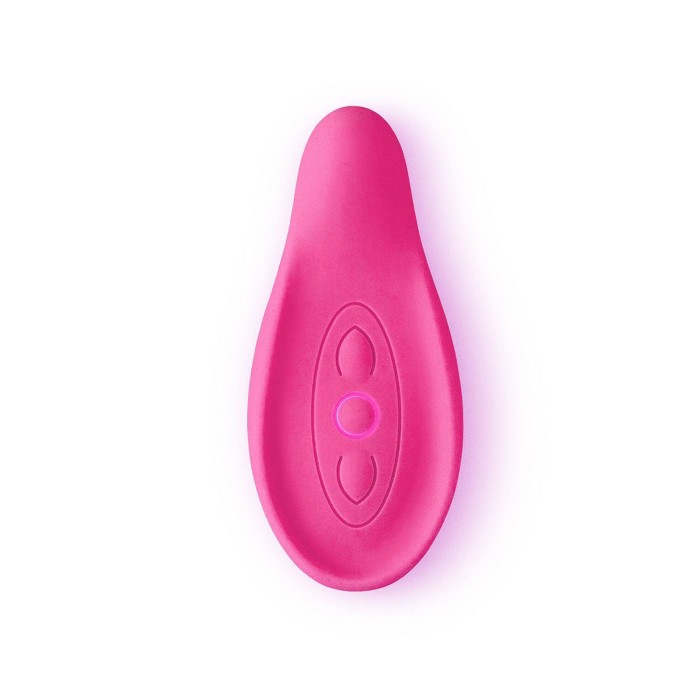
One last tip, this product I’ve seen floating around (and getting raving reviews) is called the LaVie Lactation Massager! It’s a small little massager created specifically to help clear clogged ducts and improve breast milk flow conveniently by using vibration.
If you have an electric toothbrush at home, you can try that out for vibration too.
Try the Haakaa Epsom Salt Hack (step by step on how to use Haakaa and Epsom salt)!
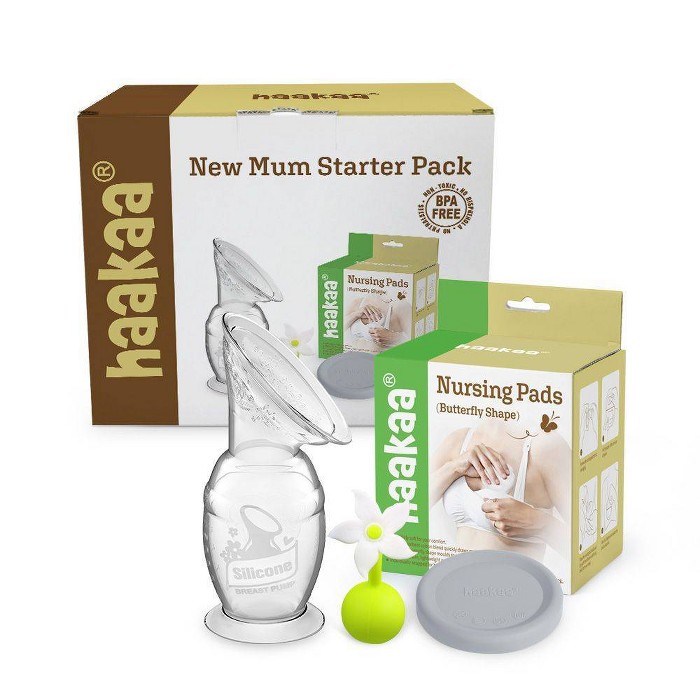
The Haakaa hack saved me big time when I had horrible mastitis. I went from feeling completely normal to feeling incredibly sick with horrible flu-like symptoms. I actually ended up being admitted to the hospital for IV antibiotics because of how fast my mastitis got out of control. I think my son was only 3 months old at the time so as you can imagine, it was hard to be away from him.
Once I was discharged, I was already starting to feel better, but the clogged duct remained. So, I decided to try the Haakaa hack to hopefully help prevent another breast infection.
The idea is to submerge your nipple into warm salt water mixed together with the added suction from the Haakaa pump to help draw out the clogged milk.
You can learn more about how to use the Haakaa Epsom Salt Hack right here.
Try Dangle Feeding
If you’re a breastfeeding mother who nurses her baby, you can try dangle feeding to let gravity do some work to suck out that painful lump. Don’t worry, it isn’t harmful to your baby.
The easiest way to do this breastfeeding technique is to place your baby on a flat surface on their back. Then, get onto your hands and knees and dangle your breast over them as they latch onto and breastfeed from the affected side.
When I polled my Instagram following, some moms reported this to be the fastest way to relieve the affected area with a clog. It might not be the best way for you, but all else is failing, might as well give it a try!
Ask Your Partner to Help
Not all partners will be up to the task of trying to suck out the hard lump of milk stuck in your breast, but it’s worth a shot!
To do this, try taking a nice hot shower and running some warm water over the affected breast. This should help soften the clogged milk and make it easier to suck out. Then, have your partner try to suck out the clog.
My partner was a bit freaked out by this idea, but if yours is up to the task, it never hurts to ask!
Sunflower Lecithin
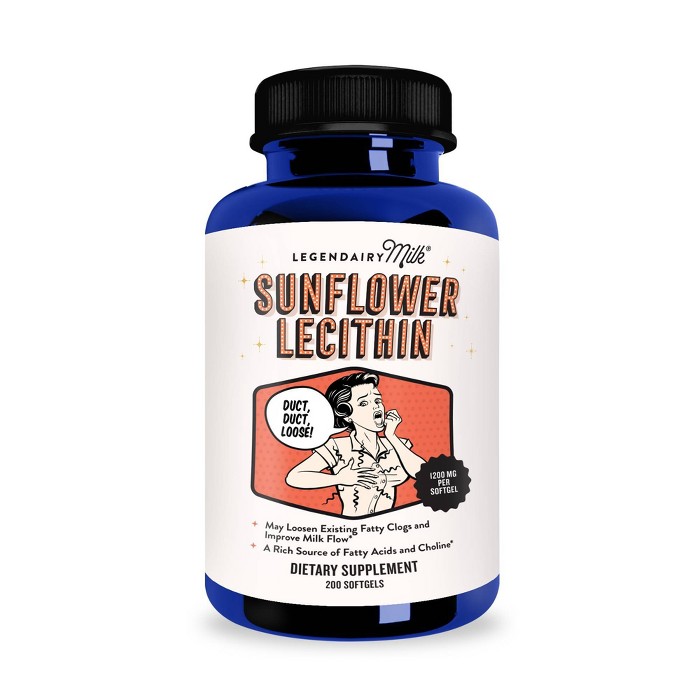
Lecithin is a mixture of choline, choline esters, fatty acids, glycerol, glycolipids, triglycerides, phosphoric acid, and phospholipids which are all normal components of human milk.
It is a fat emulsifier meaning it is thought to minimize the thick, stickiness of breast milk that causes it to get backed up forming a clog.
However, a new study done in 2021 showed that the consumption of emulsifiers (including lecithin) can “directly alter gut microbiota in a manner expected to promote intestinal inflammation”.
With that said, some IBCLCs don’t recommend using sunflower lecithin supplements if it can be avoided while others still feel it’s useful. If you feel like this is an option to consider, chat with your lactation consultant to see if it’s the best way to combat plugged milk ducts for you.
How to Unclog a Milk Duct by Increasing Nursing or Adding a Pumping Session
Adding in an extra nursing or pumping session can be another great way to draw out the clog. You will likely have some pain close to the area of engorgement, but the more you pump or nurse your baby, the better chance you have of dislodging that clogged-up milk.
If it’s too painful to pump or nurse, try applying a cold compress directly onto the area of your breast that is hot & inflamed. If you use the same warm packs as I do, you’ll be glad to know they also double as a cold pack! Win-win!
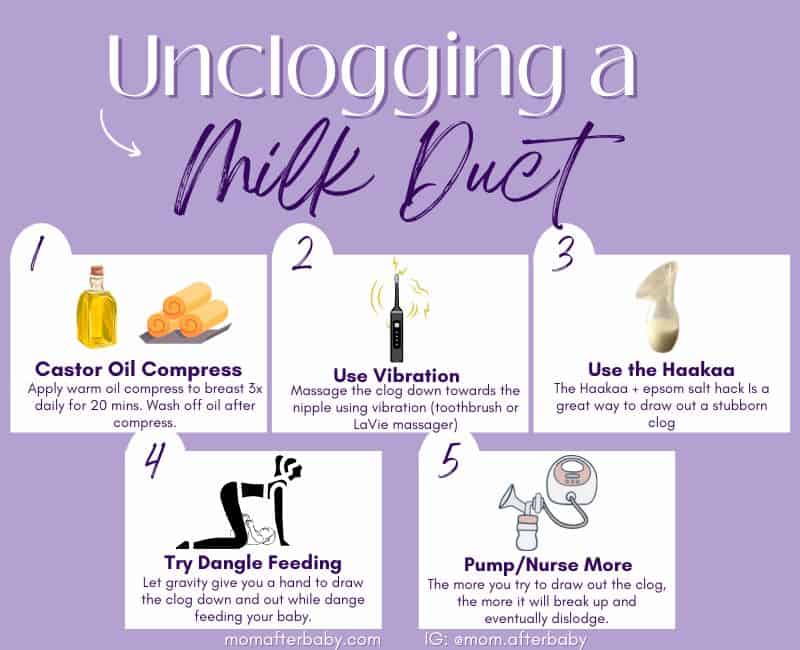
What Causes a Clogged Milk Duct?
A clogged milk duct is when your breast milk becomes obstructed within the milk duct.
Sometimes, it can be caused by a milk blister blocking the milk from exiting from your nipple.
Symptoms typically come on gradually and include:
- Swollen/tender lump in the breast
- Slow or no milk flow to the affected breast
- Hot or red skin on the affected breast
- Pain or discomfort during a letdown
- Sometimes, a noticeable small white milk bleb at the opening of your nipple
Common reasons a clogged milk duct occurs are:
- Missed feedings/pumping sessions
- Going too long between emptying your breasts
- Not emptying your breasts FULLY during a feed/pump (due to inefficient latching, not nursing long enough, not pumping long enough, using wrong flange sizes, etc…)
- Wearing a tight bra or tight clothing that hinders milk flow
- Producing too much milk (breast milk oversupply)
How Long Does a Clogged Milk Duct Last?
A clogged milk duct can last a while if not treated or unclogged correctly. If left untreated, you run the risk of developing an infection also known as mastitis.
Mastitis is when the breast tissue becomes inflamed and infected. It is quite uncomfortable and the clogged area is often painful. Hence the importance of taking appropriate steps to get that duct unclogged as soon as you suspect it.
Below, is a video by a very well-respected International Board Certified Lactation Consultant (IBCLC) — she explains the importance of unclogging a milk duct along with tips to get it done fast!
Can I Pump or Breastfeed With a Clogged Milk Duct?
Absolutely! In fact, one method to help relieve a clogged milk duct is to increase your nursing or pumping sessions (which we talked about above).
Clearing a clogged milk duct FAQ:
Now that you know the BEST remedies to help you clear out a plugged milk duct once and for all, let’s finish off with some common questions so that it all makes sense.
How Does Epsom Salt Help Clogged Milk Ducts?
Epsom salt is thought to help relieve a clogged milk duct in two ways.
- It can help to actively draw out the clog (when paired with warmth and in a Haakaa with actual suction, this only intensifies its abilities).
- It can calm and reduce the swelling, allowing for the clog to pass through more easily.
Can Anyone Take Sunflower Lecithin for Plugged Ducts?
Although lecithin for plugged ducts is generally known to be safe, you should always consult with your medical provider and/or lactation consultant before adding any kind of supplements into your diet. Especially, with the new research that came out.
What Should You Do If Your Clogged Milk Duct Won’t Unclog?
If you’ve tried the clogged milk duct hacks above and are STILL unable to bust that clog, you should discuss the next steps with your lactation consultant right away.
If you’re making slow progress, but starting to feel signs of sickness (fever, chills, dizziness, muscle aches) it could be progressing to mastitis and you should talk with your doctor right away.
I hope these tips help you bust that stubborn clog. If one of them helps, I’d love to know which one helped you clear your clogged milk duct.
Looking for more BREASTFEEDING tips & advice?


